Case Study on Project Management: Building Hudson Yards Analysis
VerifiedAdded on 2023/01/19
|21
|3231
|78
Case Study
AI Summary
This case study provides a comprehensive overview of the project management strategies employed in the construction of Hudson Yards, a significant development project in New York City. It begins with a project overview, detailing the overall budget of US$20 billion, the social and economic rationale behind the project, and key statistics such as scope, size (1,055,000 square feet), budget, and timeline. The study highlights the project's contribution to job creation and the city's GDP, as well as its environmental costs and benefits. It further discusses funding mechanisms involving the US Government and Metropolitan Transit Authority, and identifies key stakeholders. A detailed risk analysis is presented, including both qualitative and quantitative measures of risks, such as construction, equipment, financial, and resource risks, along with a risk matrix. Finally, the case study outlines a risk mitigation plan, proposing treatments for identified risks and evaluating their cost and impact. This assignment is available on Desklib, where students can find a wealth of similar solved assignments and past papers.
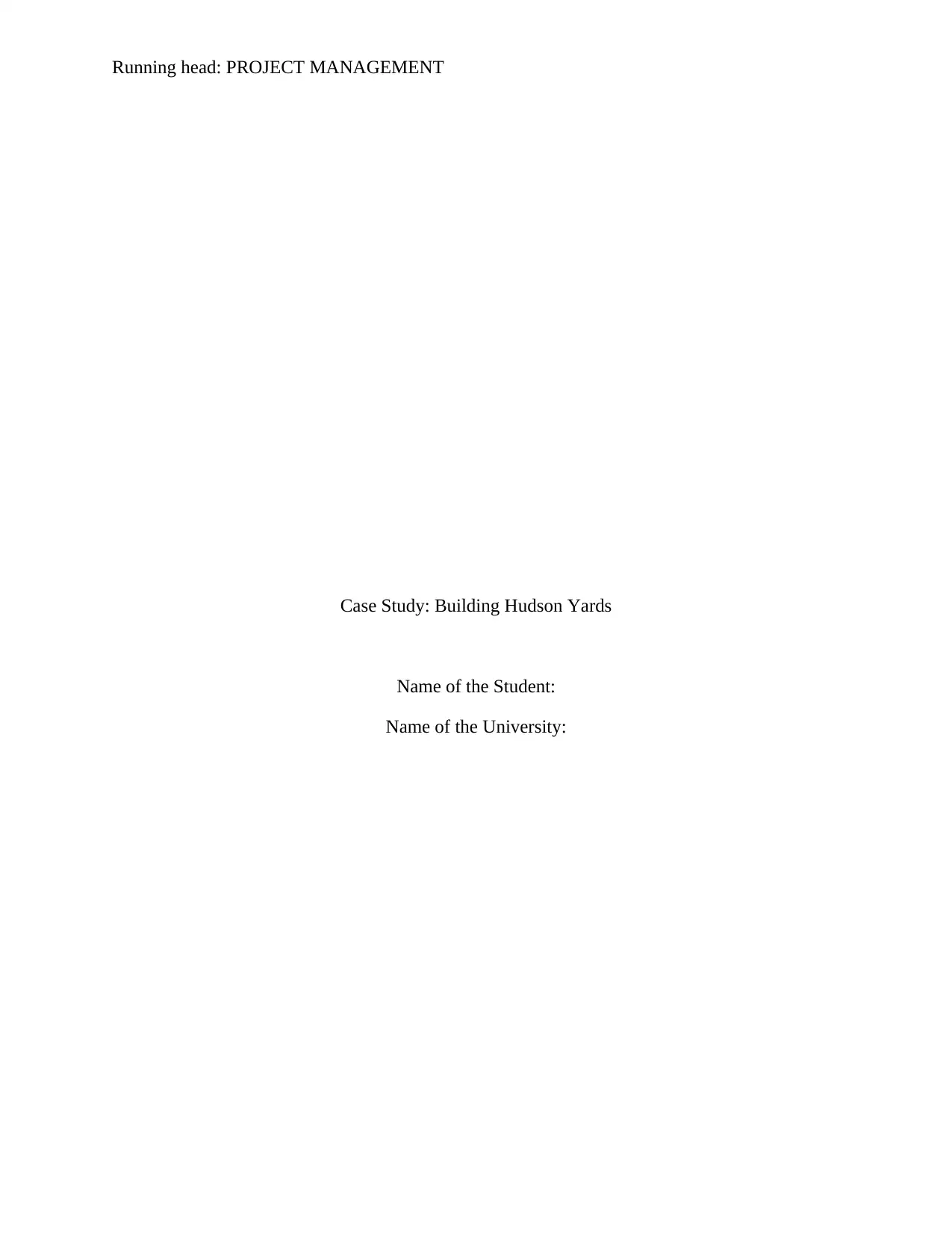
Running head: PROJECT MANAGEMENT
Case Study: Building Hudson Yards
Name of the Student:
Name of the University:
Case Study: Building Hudson Yards
Name of the Student:
Name of the University:
Paraphrase This Document
Need a fresh take? Get an instant paraphrase of this document with our AI Paraphraser
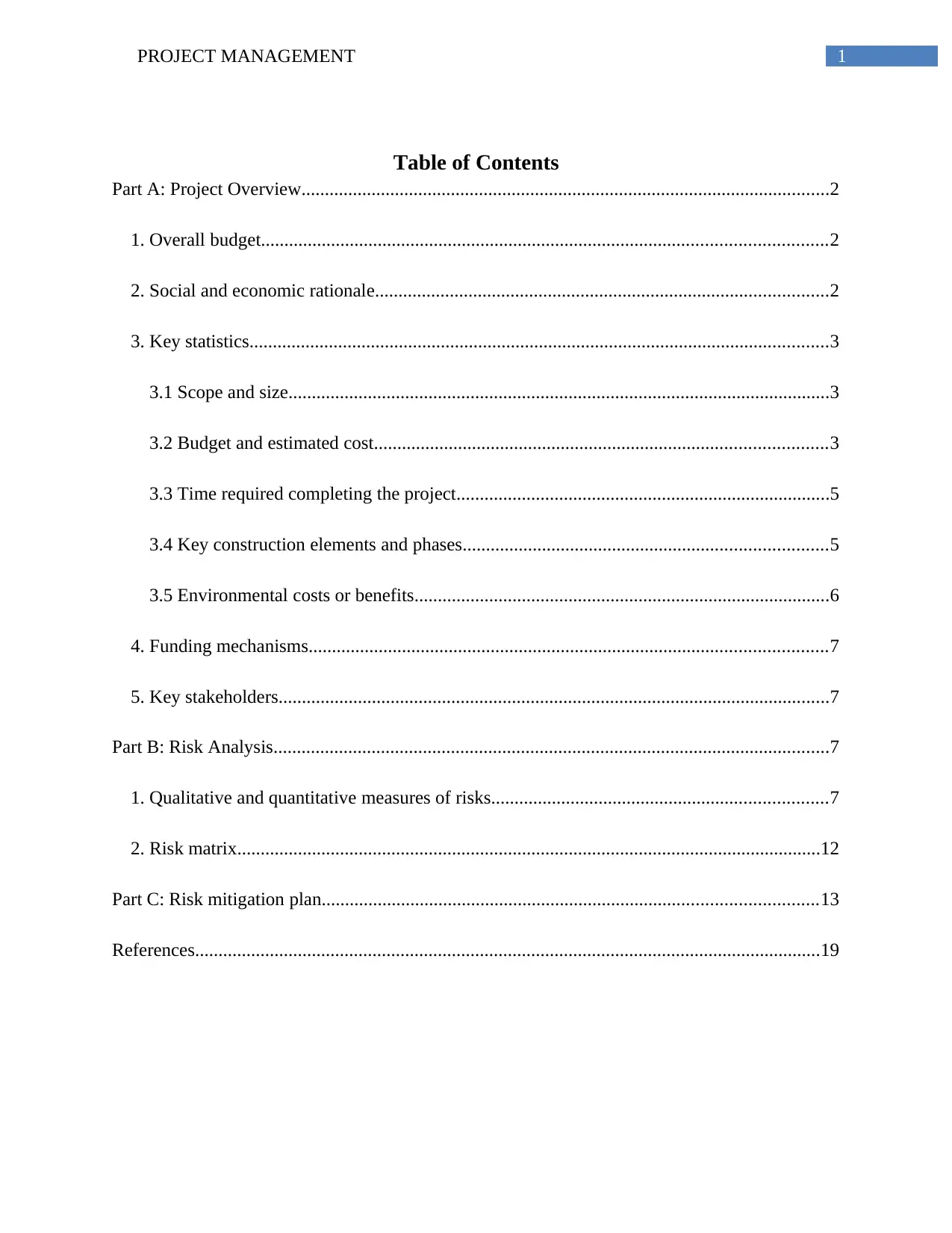
1PROJECT MANAGEMENT
Table of Contents
Part A: Project Overview.................................................................................................................2
1. Overall budget.........................................................................................................................2
2. Social and economic rationale.................................................................................................2
3. Key statistics............................................................................................................................3
3.1 Scope and size....................................................................................................................3
3.2 Budget and estimated cost.................................................................................................3
3.3 Time required completing the project................................................................................5
3.4 Key construction elements and phases..............................................................................5
3.5 Environmental costs or benefits.........................................................................................6
4. Funding mechanisms...............................................................................................................7
5. Key stakeholders......................................................................................................................7
Part B: Risk Analysis.......................................................................................................................7
1. Qualitative and quantitative measures of risks........................................................................7
2. Risk matrix.............................................................................................................................12
Part C: Risk mitigation plan..........................................................................................................13
References......................................................................................................................................19
Table of Contents
Part A: Project Overview.................................................................................................................2
1. Overall budget.........................................................................................................................2
2. Social and economic rationale.................................................................................................2
3. Key statistics............................................................................................................................3
3.1 Scope and size....................................................................................................................3
3.2 Budget and estimated cost.................................................................................................3
3.3 Time required completing the project................................................................................5
3.4 Key construction elements and phases..............................................................................5
3.5 Environmental costs or benefits.........................................................................................6
4. Funding mechanisms...............................................................................................................7
5. Key stakeholders......................................................................................................................7
Part B: Risk Analysis.......................................................................................................................7
1. Qualitative and quantitative measures of risks........................................................................7
2. Risk matrix.............................................................................................................................12
Part C: Risk mitigation plan..........................................................................................................13
References......................................................................................................................................19
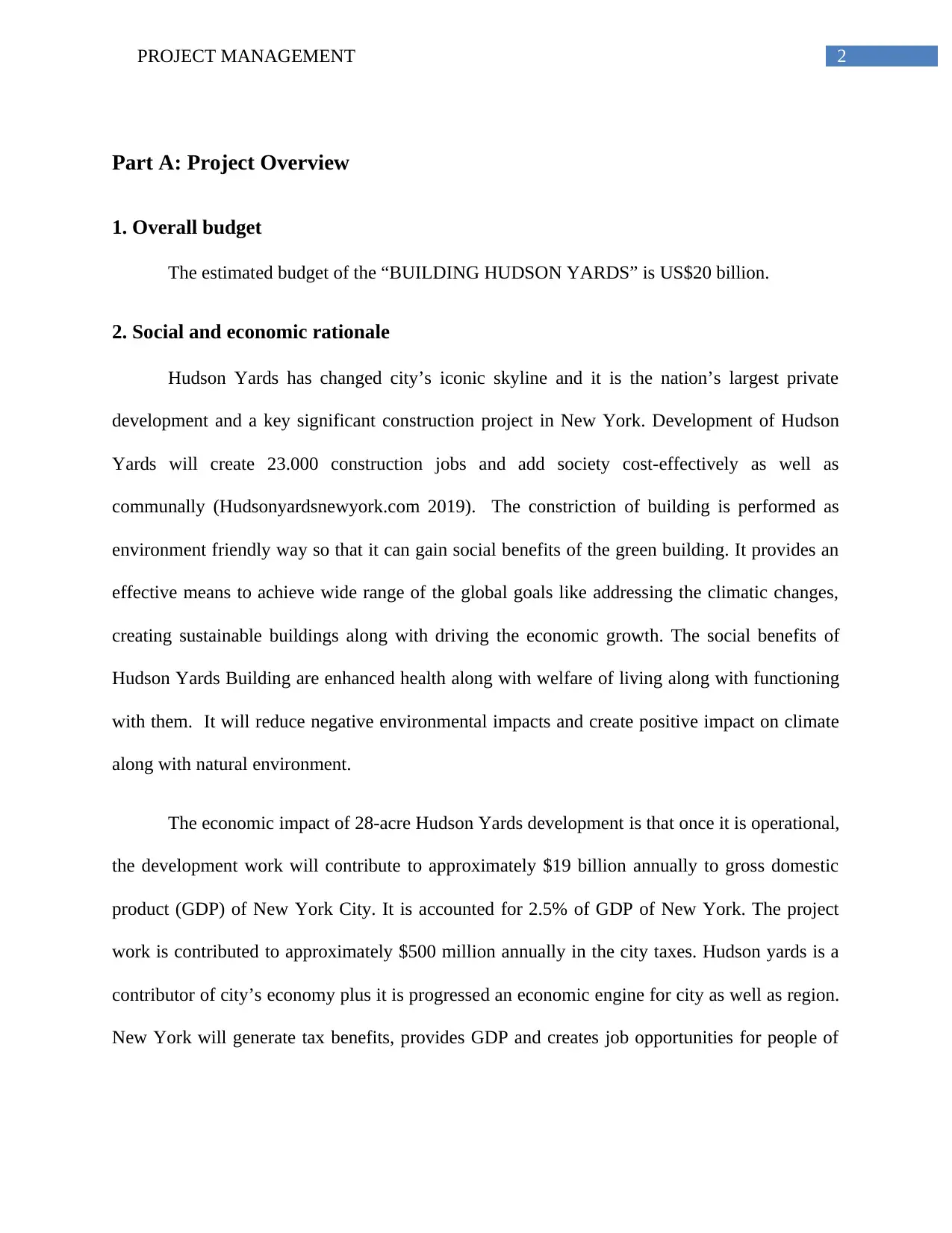
2PROJECT MANAGEMENT
Part A: Project Overview
1. Overall budget
The estimated budget of the “BUILDING HUDSON YARDS” is US$20 billion.
2. Social and economic rationale
Hudson Yards has changed city’s iconic skyline and it is the nation’s largest private
development and a key significant construction project in New York. Development of Hudson
Yards will create 23.000 construction jobs and add society cost-effectively as well as
communally (Hudsonyardsnewyork.com 2019). The constriction of building is performed as
environment friendly way so that it can gain social benefits of the green building. It provides an
effective means to achieve wide range of the global goals like addressing the climatic changes,
creating sustainable buildings along with driving the economic growth. The social benefits of
Hudson Yards Building are enhanced health along with welfare of living along with functioning
with them. It will reduce negative environmental impacts and create positive impact on climate
along with natural environment.
The economic impact of 28-acre Hudson Yards development is that once it is operational,
the development work will contribute to approximately $19 billion annually to gross domestic
product (GDP) of New York City. It is accounted for 2.5% of GDP of New York. The project
work is contributed to approximately $500 million annually in the city taxes. Hudson yards is a
contributor of city’s economy plus it is progressed an economic engine for city as well as region.
New York will generate tax benefits, provides GDP and creates job opportunities for people of
Part A: Project Overview
1. Overall budget
The estimated budget of the “BUILDING HUDSON YARDS” is US$20 billion.
2. Social and economic rationale
Hudson Yards has changed city’s iconic skyline and it is the nation’s largest private
development and a key significant construction project in New York. Development of Hudson
Yards will create 23.000 construction jobs and add society cost-effectively as well as
communally (Hudsonyardsnewyork.com 2019). The constriction of building is performed as
environment friendly way so that it can gain social benefits of the green building. It provides an
effective means to achieve wide range of the global goals like addressing the climatic changes,
creating sustainable buildings along with driving the economic growth. The social benefits of
Hudson Yards Building are enhanced health along with welfare of living along with functioning
with them. It will reduce negative environmental impacts and create positive impact on climate
along with natural environment.
The economic impact of 28-acre Hudson Yards development is that once it is operational,
the development work will contribute to approximately $19 billion annually to gross domestic
product (GDP) of New York City. It is accounted for 2.5% of GDP of New York. The project
work is contributed to approximately $500 million annually in the city taxes. Hudson yards is a
contributor of city’s economy plus it is progressed an economic engine for city as well as region.
New York will generate tax benefits, provides GDP and creates job opportunities for people of
⊘ This is a preview!⊘
Do you want full access?
Subscribe today to unlock all pages.

Trusted by 1+ million students worldwide
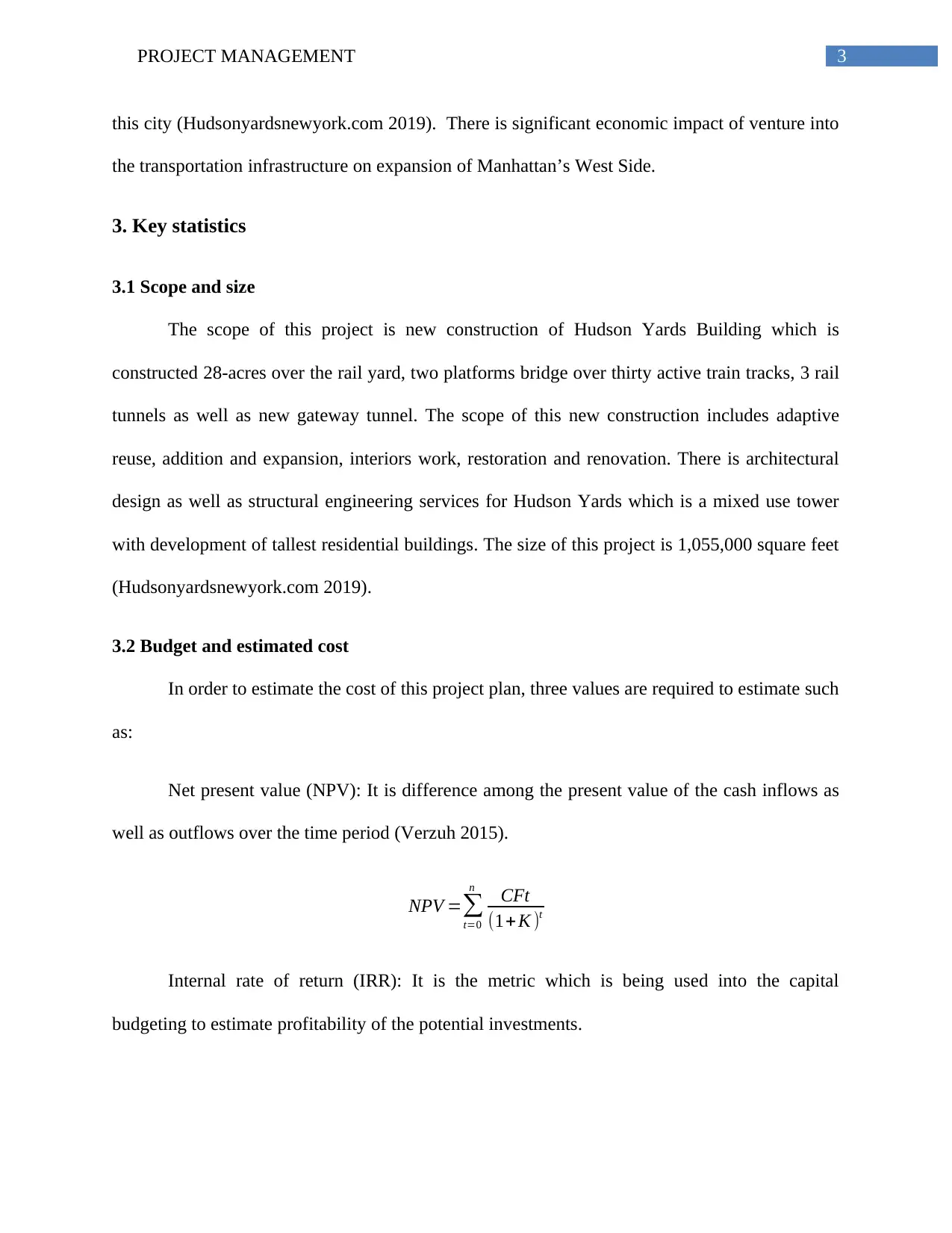
3PROJECT MANAGEMENT
this city (Hudsonyardsnewyork.com 2019). There is significant economic impact of venture into
the transportation infrastructure on expansion of Manhattan’s West Side.
3. Key statistics
3.1 Scope and size
The scope of this project is new construction of Hudson Yards Building which is
constructed 28-acres over the rail yard, two platforms bridge over thirty active train tracks, 3 rail
tunnels as well as new gateway tunnel. The scope of this new construction includes adaptive
reuse, addition and expansion, interiors work, restoration and renovation. There is architectural
design as well as structural engineering services for Hudson Yards which is a mixed use tower
with development of tallest residential buildings. The size of this project is 1,055,000 square feet
(Hudsonyardsnewyork.com 2019).
3.2 Budget and estimated cost
In order to estimate the cost of this project plan, three values are required to estimate such
as:
Net present value (NPV): It is difference among the present value of the cash inflows as
well as outflows over the time period (Verzuh 2015).
NPV =∑
t=0
n CFt
(1+ K )t
Internal rate of return (IRR): It is the metric which is being used into the capital
budgeting to estimate profitability of the potential investments.
this city (Hudsonyardsnewyork.com 2019). There is significant economic impact of venture into
the transportation infrastructure on expansion of Manhattan’s West Side.
3. Key statistics
3.1 Scope and size
The scope of this project is new construction of Hudson Yards Building which is
constructed 28-acres over the rail yard, two platforms bridge over thirty active train tracks, 3 rail
tunnels as well as new gateway tunnel. The scope of this new construction includes adaptive
reuse, addition and expansion, interiors work, restoration and renovation. There is architectural
design as well as structural engineering services for Hudson Yards which is a mixed use tower
with development of tallest residential buildings. The size of this project is 1,055,000 square feet
(Hudsonyardsnewyork.com 2019).
3.2 Budget and estimated cost
In order to estimate the cost of this project plan, three values are required to estimate such
as:
Net present value (NPV): It is difference among the present value of the cash inflows as
well as outflows over the time period (Verzuh 2015).
NPV =∑
t=0
n CFt
(1+ K )t
Internal rate of return (IRR): It is the metric which is being used into the capital
budgeting to estimate profitability of the potential investments.
Paraphrase This Document
Need a fresh take? Get an instant paraphrase of this document with our AI Paraphraser
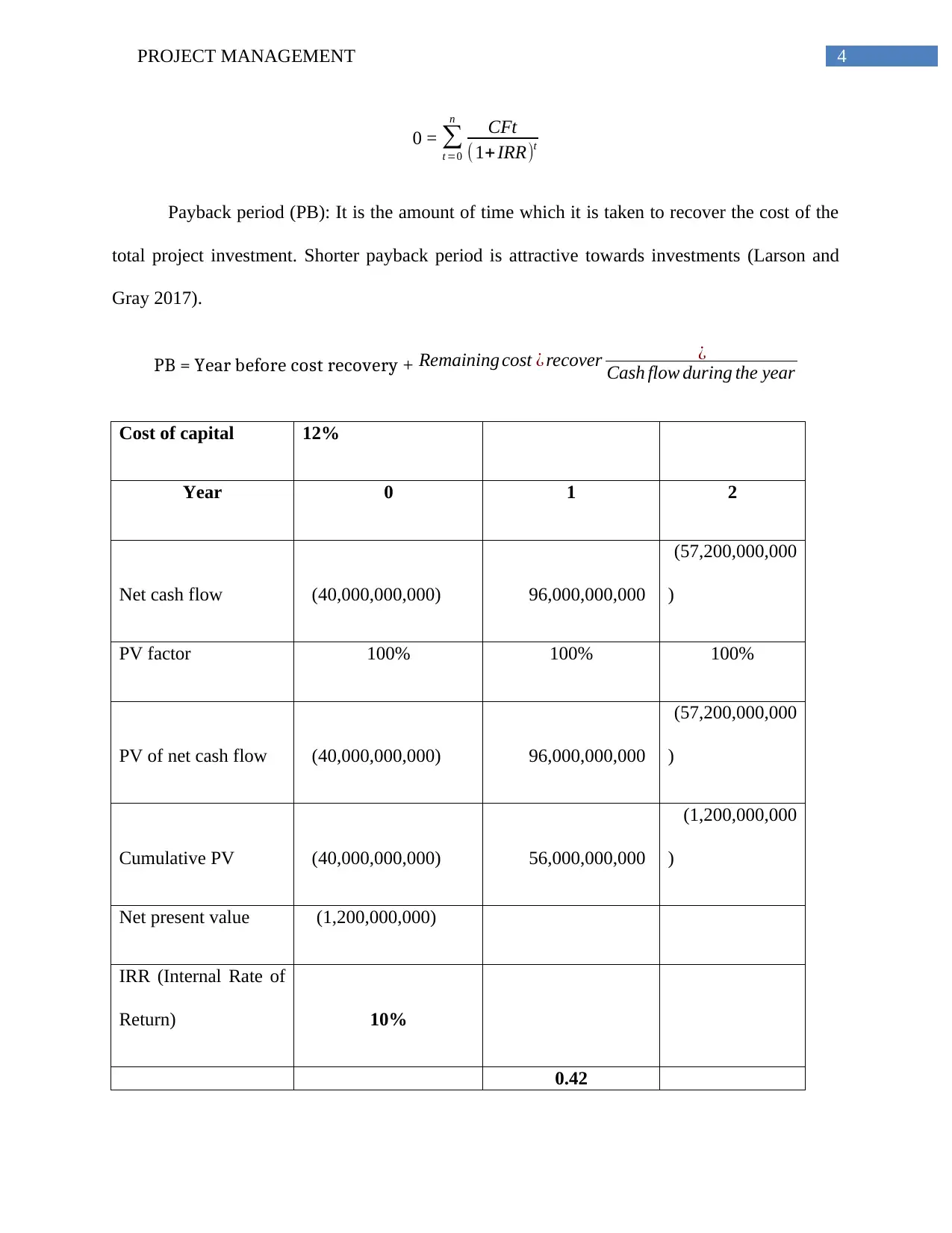
4PROJECT MANAGEMENT
0 = ∑
t =0
n CFt
(1+IRR)t
Payback period (PB): It is the amount of time which it is taken to recover the cost of the
total project investment. Shorter payback period is attractive towards investments (Larson and
Gray 2017).
PB = Year before cost recovery + Remaining cost ¿ recover ¿
Cash flow during the year
Cost of capital 12%
Year 0 1 2
Net cash flow (40,000,000,000) 96,000,000,000
(57,200,000,000
)
PV factor 100% 100% 100%
PV of net cash flow (40,000,000,000) 96,000,000,000
(57,200,000,000
)
Cumulative PV (40,000,000,000) 56,000,000,000
(1,200,000,000
)
Net present value (1,200,000,000)
IRR (Internal Rate of
Return) 10%
0.42
0 = ∑
t =0
n CFt
(1+IRR)t
Payback period (PB): It is the amount of time which it is taken to recover the cost of the
total project investment. Shorter payback period is attractive towards investments (Larson and
Gray 2017).
PB = Year before cost recovery + Remaining cost ¿ recover ¿
Cash flow during the year
Cost of capital 12%
Year 0 1 2
Net cash flow (40,000,000,000) 96,000,000,000
(57,200,000,000
)
PV factor 100% 100% 100%
PV of net cash flow (40,000,000,000) 96,000,000,000
(57,200,000,000
)
Cumulative PV (40,000,000,000) 56,000,000,000
(1,200,000,000
)
Net present value (1,200,000,000)
IRR (Internal Rate of
Return) 10%
0.42
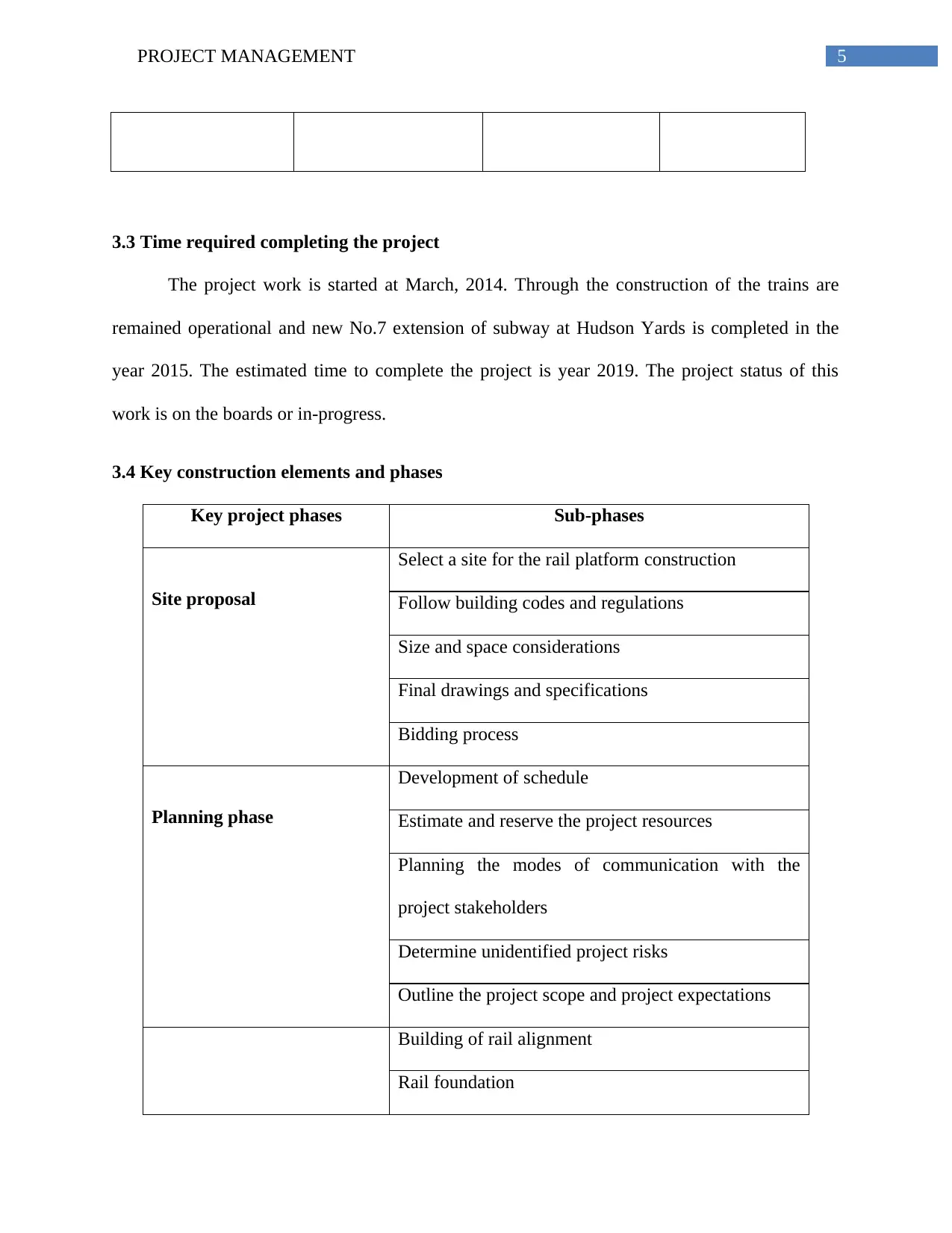
5PROJECT MANAGEMENT
3.3 Time required completing the project
The project work is started at March, 2014. Through the construction of the trains are
remained operational and new No.7 extension of subway at Hudson Yards is completed in the
year 2015. The estimated time to complete the project is year 2019. The project status of this
work is on the boards or in-progress.
3.4 Key construction elements and phases
Key project phases Sub-phases
Site proposal
Select a site for the rail platform construction
Follow building codes and regulations
Size and space considerations
Final drawings and specifications
Bidding process
Planning phase
Development of schedule
Estimate and reserve the project resources
Planning the modes of communication with the
project stakeholders
Determine unidentified project risks
Outline the project scope and project expectations
Building of rail alignment
Rail foundation
3.3 Time required completing the project
The project work is started at March, 2014. Through the construction of the trains are
remained operational and new No.7 extension of subway at Hudson Yards is completed in the
year 2015. The estimated time to complete the project is year 2019. The project status of this
work is on the boards or in-progress.
3.4 Key construction elements and phases
Key project phases Sub-phases
Site proposal
Select a site for the rail platform construction
Follow building codes and regulations
Size and space considerations
Final drawings and specifications
Bidding process
Planning phase
Development of schedule
Estimate and reserve the project resources
Planning the modes of communication with the
project stakeholders
Determine unidentified project risks
Outline the project scope and project expectations
Building of rail alignment
Rail foundation
⊘ This is a preview!⊘
Do you want full access?
Subscribe today to unlock all pages.

Trusted by 1+ million students worldwide
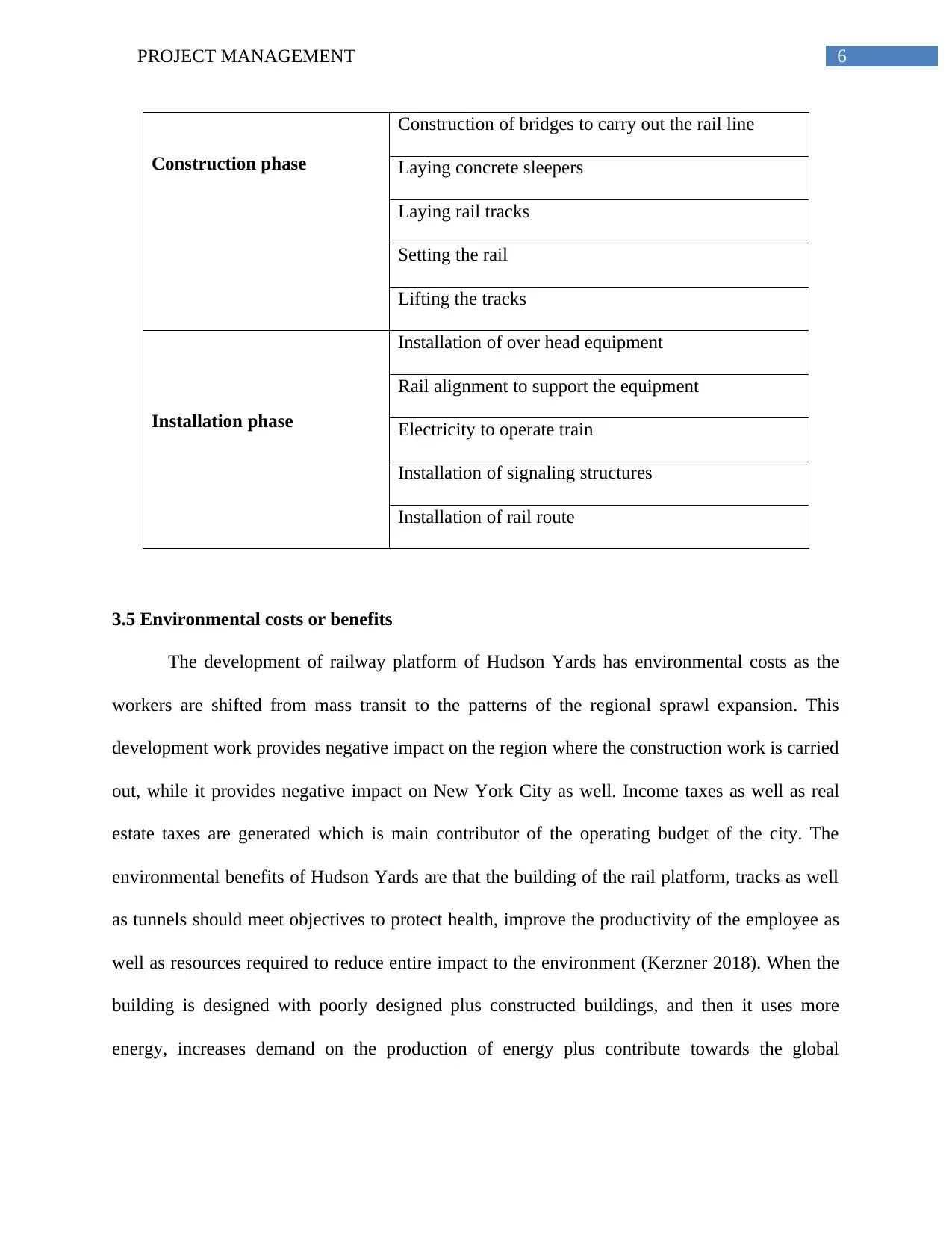
6PROJECT MANAGEMENT
Construction phase
Construction of bridges to carry out the rail line
Laying concrete sleepers
Laying rail tracks
Setting the rail
Lifting the tracks
Installation phase
Installation of over head equipment
Rail alignment to support the equipment
Electricity to operate train
Installation of signaling structures
Installation of rail route
3.5 Environmental costs or benefits
The development of railway platform of Hudson Yards has environmental costs as the
workers are shifted from mass transit to the patterns of the regional sprawl expansion. This
development work provides negative impact on the region where the construction work is carried
out, while it provides negative impact on New York City as well. Income taxes as well as real
estate taxes are generated which is main contributor of the operating budget of the city. The
environmental benefits of Hudson Yards are that the building of the rail platform, tracks as well
as tunnels should meet objectives to protect health, improve the productivity of the employee as
well as resources required to reduce entire impact to the environment (Kerzner 2018). When the
building is designed with poorly designed plus constructed buildings, and then it uses more
energy, increases demand on the production of energy plus contribute towards the global
Construction phase
Construction of bridges to carry out the rail line
Laying concrete sleepers
Laying rail tracks
Setting the rail
Lifting the tracks
Installation phase
Installation of over head equipment
Rail alignment to support the equipment
Electricity to operate train
Installation of signaling structures
Installation of rail route
3.5 Environmental costs or benefits
The development of railway platform of Hudson Yards has environmental costs as the
workers are shifted from mass transit to the patterns of the regional sprawl expansion. This
development work provides negative impact on the region where the construction work is carried
out, while it provides negative impact on New York City as well. Income taxes as well as real
estate taxes are generated which is main contributor of the operating budget of the city. The
environmental benefits of Hudson Yards are that the building of the rail platform, tracks as well
as tunnels should meet objectives to protect health, improve the productivity of the employee as
well as resources required to reduce entire impact to the environment (Kerzner 2018). When the
building is designed with poorly designed plus constructed buildings, and then it uses more
energy, increases demand on the production of energy plus contribute towards the global
Paraphrase This Document
Need a fresh take? Get an instant paraphrase of this document with our AI Paraphraser
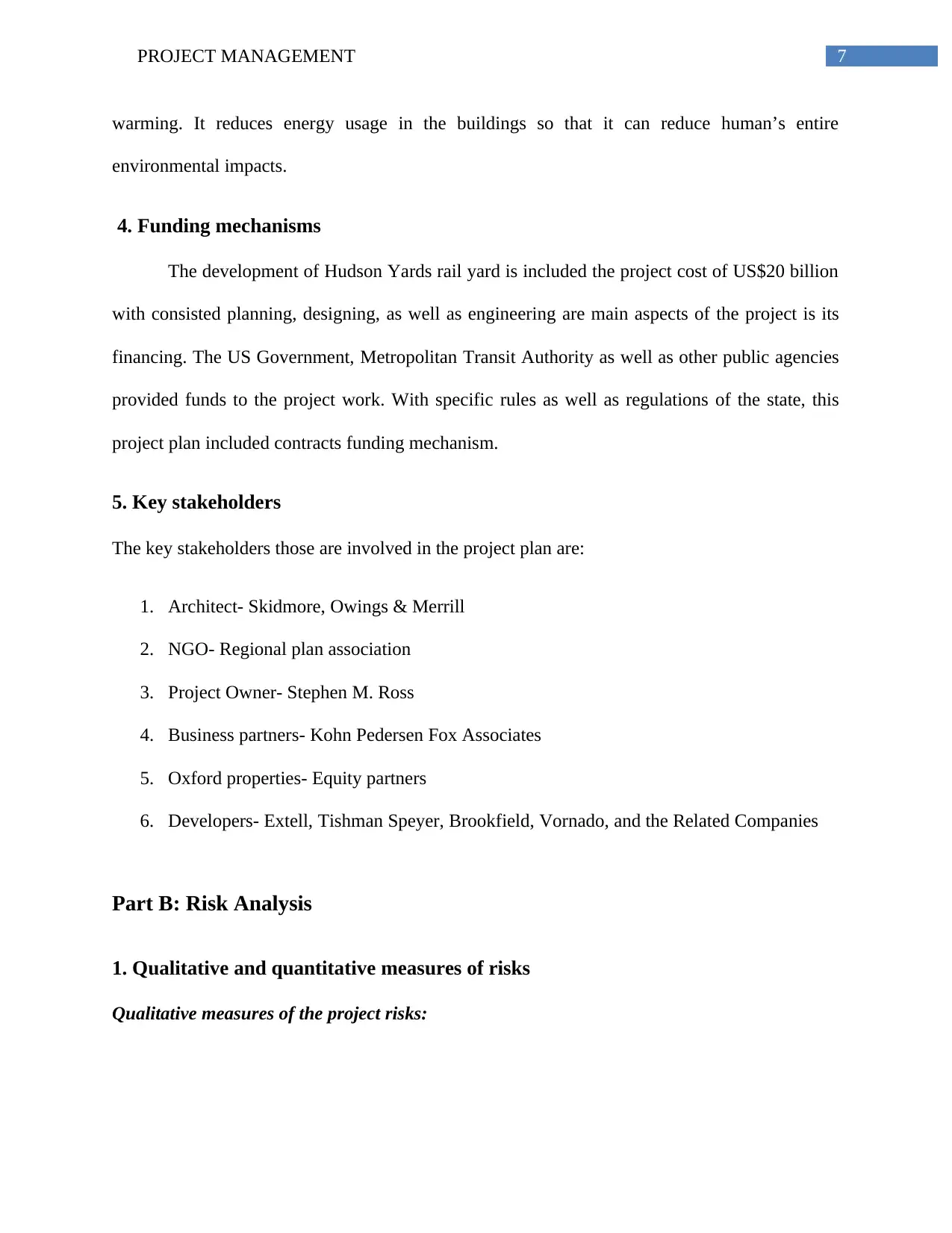
7PROJECT MANAGEMENT
warming. It reduces energy usage in the buildings so that it can reduce human’s entire
environmental impacts.
4. Funding mechanisms
The development of Hudson Yards rail yard is included the project cost of US$20 billion
with consisted planning, designing, as well as engineering are main aspects of the project is its
financing. The US Government, Metropolitan Transit Authority as well as other public agencies
provided funds to the project work. With specific rules as well as regulations of the state, this
project plan included contracts funding mechanism.
5. Key stakeholders
The key stakeholders those are involved in the project plan are:
1. Architect- Skidmore, Owings & Merrill
2. NGO- Regional plan association
3. Project Owner- Stephen M. Ross
4. Business partners- Kohn Pedersen Fox Associates
5. Oxford properties- Equity partners
6. Developers- Extell, Tishman Speyer, Brookfield, Vornado, and the Related Companies
Part B: Risk Analysis
1. Qualitative and quantitative measures of risks
Qualitative measures of the project risks:
warming. It reduces energy usage in the buildings so that it can reduce human’s entire
environmental impacts.
4. Funding mechanisms
The development of Hudson Yards rail yard is included the project cost of US$20 billion
with consisted planning, designing, as well as engineering are main aspects of the project is its
financing. The US Government, Metropolitan Transit Authority as well as other public agencies
provided funds to the project work. With specific rules as well as regulations of the state, this
project plan included contracts funding mechanism.
5. Key stakeholders
The key stakeholders those are involved in the project plan are:
1. Architect- Skidmore, Owings & Merrill
2. NGO- Regional plan association
3. Project Owner- Stephen M. Ross
4. Business partners- Kohn Pedersen Fox Associates
5. Oxford properties- Equity partners
6. Developers- Extell, Tishman Speyer, Brookfield, Vornado, and the Related Companies
Part B: Risk Analysis
1. Qualitative and quantitative measures of risks
Qualitative measures of the project risks:
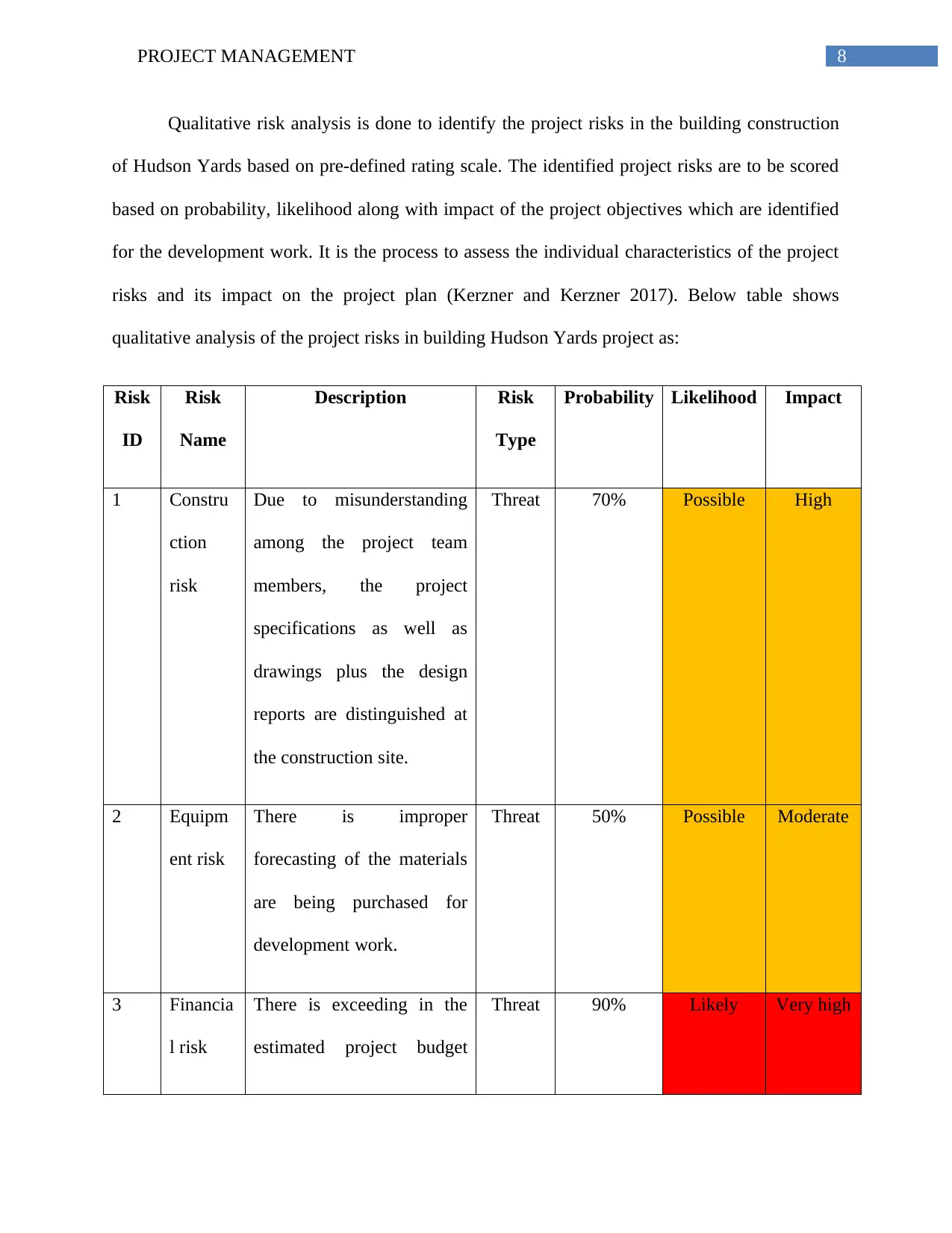
8PROJECT MANAGEMENT
Qualitative risk analysis is done to identify the project risks in the building construction
of Hudson Yards based on pre-defined rating scale. The identified project risks are to be scored
based on probability, likelihood along with impact of the project objectives which are identified
for the development work. It is the process to assess the individual characteristics of the project
risks and its impact on the project plan (Kerzner and Kerzner 2017). Below table shows
qualitative analysis of the project risks in building Hudson Yards project as:
Risk
ID
Risk
Name
Description Risk
Type
Probability Likelihood Impact
1 Constru
ction
risk
Due to misunderstanding
among the project team
members, the project
specifications as well as
drawings plus the design
reports are distinguished at
the construction site.
Threat 70% Possible High
2 Equipm
ent risk
There is improper
forecasting of the materials
are being purchased for
development work.
Threat 50% Possible Moderate
3 Financia
l risk
There is exceeding in the
estimated project budget
Threat 90% Likely Very high
Qualitative risk analysis is done to identify the project risks in the building construction
of Hudson Yards based on pre-defined rating scale. The identified project risks are to be scored
based on probability, likelihood along with impact of the project objectives which are identified
for the development work. It is the process to assess the individual characteristics of the project
risks and its impact on the project plan (Kerzner and Kerzner 2017). Below table shows
qualitative analysis of the project risks in building Hudson Yards project as:
Risk
ID
Risk
Name
Description Risk
Type
Probability Likelihood Impact
1 Constru
ction
risk
Due to misunderstanding
among the project team
members, the project
specifications as well as
drawings plus the design
reports are distinguished at
the construction site.
Threat 70% Possible High
2 Equipm
ent risk
There is improper
forecasting of the materials
are being purchased for
development work.
Threat 50% Possible Moderate
3 Financia
l risk
There is exceeding in the
estimated project budget
Threat 90% Likely Very high
⊘ This is a preview!⊘
Do you want full access?
Subscribe today to unlock all pages.

Trusted by 1+ million students worldwide
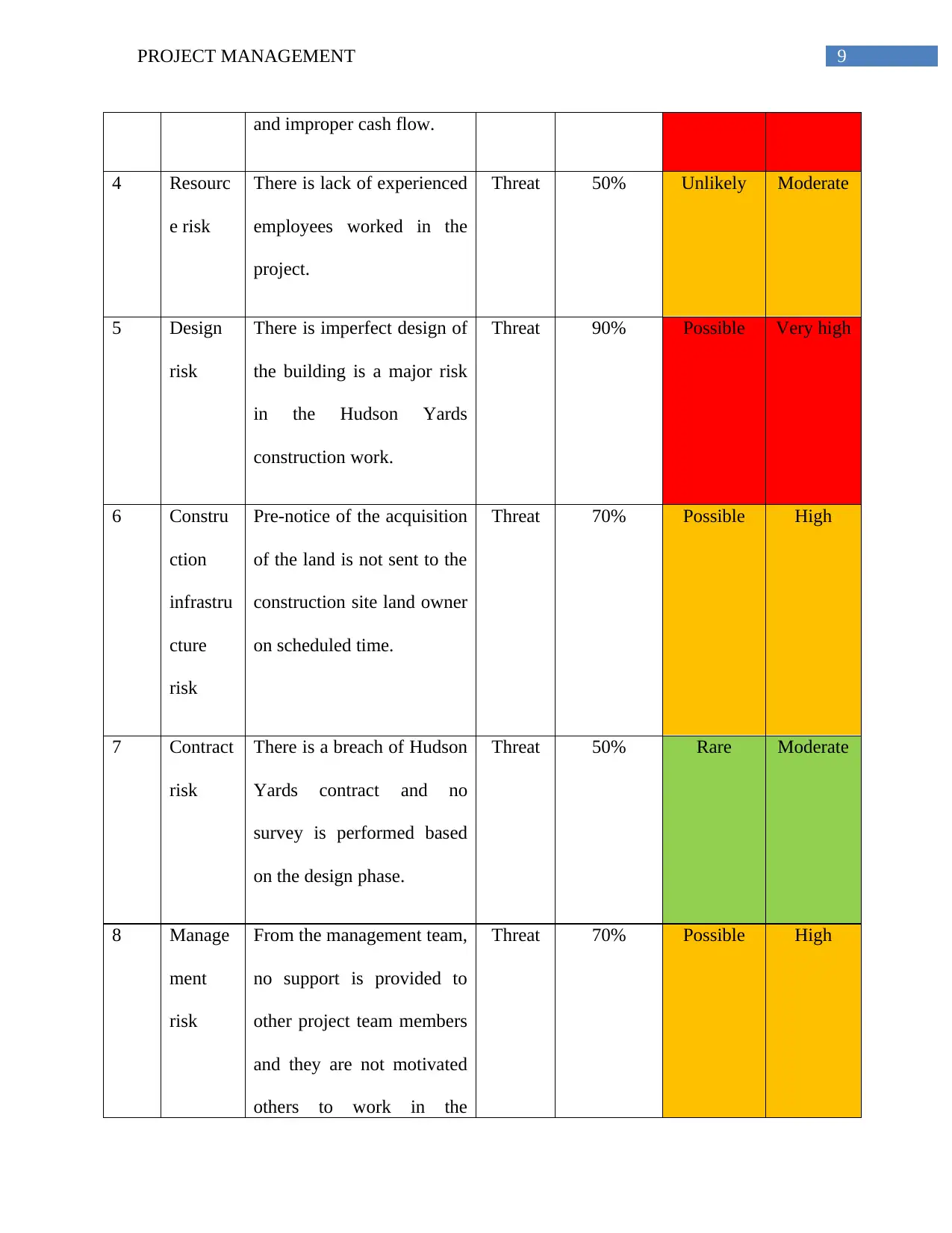
9PROJECT MANAGEMENT
and improper cash flow.
4 Resourc
e risk
There is lack of experienced
employees worked in the
project.
Threat 50% Unlikely Moderate
5 Design
risk
There is imperfect design of
the building is a major risk
in the Hudson Yards
construction work.
Threat 90% Possible Very high
6 Constru
ction
infrastru
cture
risk
Pre-notice of the acquisition
of the land is not sent to the
construction site land owner
on scheduled time.
Threat 70% Possible High
7 Contract
risk
There is a breach of Hudson
Yards contract and no
survey is performed based
on the design phase.
Threat 50% Rare Moderate
8 Manage
ment
risk
From the management team,
no support is provided to
other project team members
and they are not motivated
others to work in the
Threat 70% Possible High
and improper cash flow.
4 Resourc
e risk
There is lack of experienced
employees worked in the
project.
Threat 50% Unlikely Moderate
5 Design
risk
There is imperfect design of
the building is a major risk
in the Hudson Yards
construction work.
Threat 90% Possible Very high
6 Constru
ction
infrastru
cture
risk
Pre-notice of the acquisition
of the land is not sent to the
construction site land owner
on scheduled time.
Threat 70% Possible High
7 Contract
risk
There is a breach of Hudson
Yards contract and no
survey is performed based
on the design phase.
Threat 50% Rare Moderate
8 Manage
ment
risk
From the management team,
no support is provided to
other project team members
and they are not motivated
others to work in the
Threat 70% Possible High
Paraphrase This Document
Need a fresh take? Get an instant paraphrase of this document with our AI Paraphraser
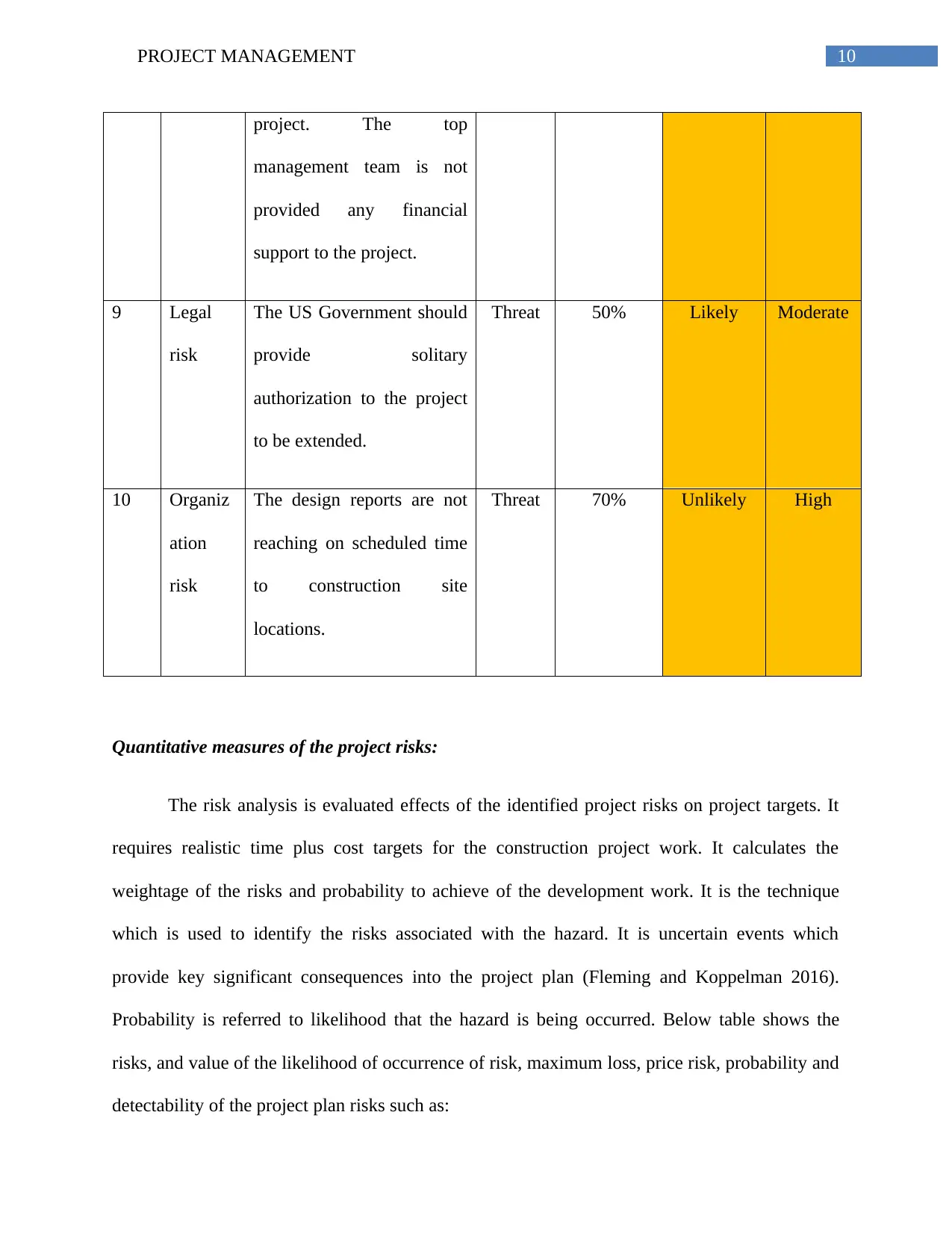
10PROJECT MANAGEMENT
project. The top
management team is not
provided any financial
support to the project.
9 Legal
risk
The US Government should
provide solitary
authorization to the project
to be extended.
Threat 50% Likely Moderate
10 Organiz
ation
risk
The design reports are not
reaching on scheduled time
to construction site
locations.
Threat 70% Unlikely High
Quantitative measures of the project risks:
The risk analysis is evaluated effects of the identified project risks on project targets. It
requires realistic time plus cost targets for the construction project work. It calculates the
weightage of the risks and probability to achieve of the development work. It is the technique
which is used to identify the risks associated with the hazard. It is uncertain events which
provide key significant consequences into the project plan (Fleming and Koppelman 2016).
Probability is referred to likelihood that the hazard is being occurred. Below table shows the
risks, and value of the likelihood of occurrence of risk, maximum loss, price risk, probability and
detectability of the project plan risks such as:
project. The top
management team is not
provided any financial
support to the project.
9 Legal
risk
The US Government should
provide solitary
authorization to the project
to be extended.
Threat 50% Likely Moderate
10 Organiz
ation
risk
The design reports are not
reaching on scheduled time
to construction site
locations.
Threat 70% Unlikely High
Quantitative measures of the project risks:
The risk analysis is evaluated effects of the identified project risks on project targets. It
requires realistic time plus cost targets for the construction project work. It calculates the
weightage of the risks and probability to achieve of the development work. It is the technique
which is used to identify the risks associated with the hazard. It is uncertain events which
provide key significant consequences into the project plan (Fleming and Koppelman 2016).
Probability is referred to likelihood that the hazard is being occurred. Below table shows the
risks, and value of the likelihood of occurrence of risk, maximum loss, price risk, probability and
detectability of the project plan risks such as:
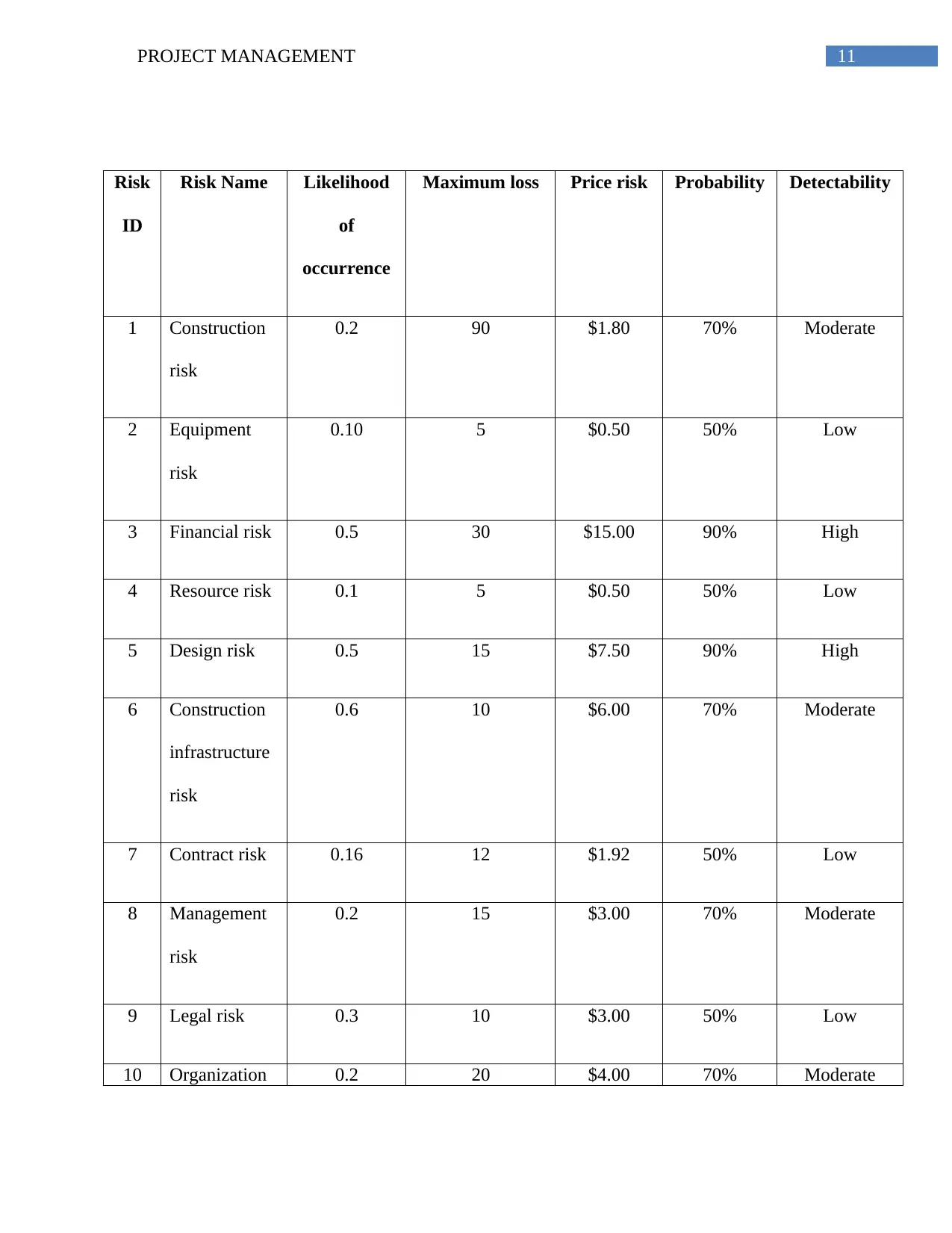
11PROJECT MANAGEMENT
Risk
ID
Risk Name Likelihood
of
occurrence
Maximum loss Price risk Probability Detectability
1 Construction
risk
0.2 90 $1.80 70% Moderate
2 Equipment
risk
0.10 5 $0.50 50% Low
3 Financial risk 0.5 30 $15.00 90% High
4 Resource risk 0.1 5 $0.50 50% Low
5 Design risk 0.5 15 $7.50 90% High
6 Construction
infrastructure
risk
0.6 10 $6.00 70% Moderate
7 Contract risk 0.16 12 $1.92 50% Low
8 Management
risk
0.2 15 $3.00 70% Moderate
9 Legal risk 0.3 10 $3.00 50% Low
10 Organization 0.2 20 $4.00 70% Moderate
Risk
ID
Risk Name Likelihood
of
occurrence
Maximum loss Price risk Probability Detectability
1 Construction
risk
0.2 90 $1.80 70% Moderate
2 Equipment
risk
0.10 5 $0.50 50% Low
3 Financial risk 0.5 30 $15.00 90% High
4 Resource risk 0.1 5 $0.50 50% Low
5 Design risk 0.5 15 $7.50 90% High
6 Construction
infrastructure
risk
0.6 10 $6.00 70% Moderate
7 Contract risk 0.16 12 $1.92 50% Low
8 Management
risk
0.2 15 $3.00 70% Moderate
9 Legal risk 0.3 10 $3.00 50% Low
10 Organization 0.2 20 $4.00 70% Moderate
⊘ This is a preview!⊘
Do you want full access?
Subscribe today to unlock all pages.

Trusted by 1+ million students worldwide
1 out of 21
Related Documents
Your All-in-One AI-Powered Toolkit for Academic Success.
+13062052269
info@desklib.com
Available 24*7 on WhatsApp / Email
![[object Object]](/_next/static/media/star-bottom.7253800d.svg)
Unlock your academic potential
Copyright © 2020–2025 A2Z Services. All Rights Reserved. Developed and managed by ZUCOL.




